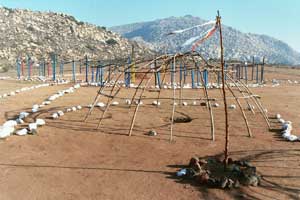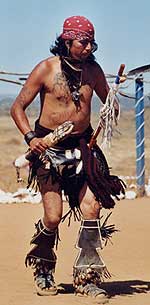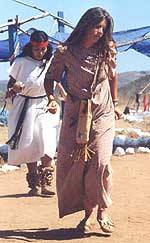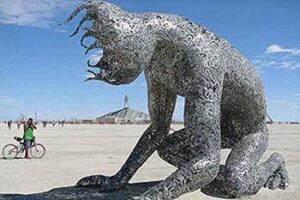Sundance: The Other Festival, in New Mexico
By Kim Kroonenburg

The conch shell cries out its resounding call as it summons young and old to the Sundance. A chalice of burning sage is offered to the skies as the hypnotic beat of the drum casts its spell. Beautifully dressed participants gather around, and my eyes grow large at the spectacular show of exotic clothing and ornaments. From knee-high leather moccasins and beaded vests to rattlesnake headbands and feather headdresses, a wide array of ancient relics abound. I gaze around me, transported back in time, aware that I am witness to an ancient ritual I thought had disappeared long ago.
For many years I’d heard captivating stories of ceremonies and purification rites, of vision quests and powerful animal medicine, of the tradition of a people who make prayers to the animals they consume, and offer gifts of tobacco to the plants they harvest. I was curious about their customs, and when the opportunity presented itself, I went to study with a Shaman in Northern Mexico.
A Shaman’s apprentice participates in various rituals, but none is as powerful as the Sundance. Kachora, a Yaqui Native American elder, organizes this yearly ceremony to share his vision with the world. It celebrates the summer solstice with four days of dancing, prayer and sweat lodges, and invites everyone interested in this ancient custom. Since antiquity, dance has been a way for Native Americans to express their ways and affirm their beliefs, playing a central part of a tribe’s history.
The Ceremonial Site
Clouds of dust rose up and swirled around my car like undersized tornadoes, but my trusty vehicle rattled on, braving the primitive dirt road leading to the dance site. After a bumpy drive through the barren Mexican landscape, the Sundance site finally appeared like a mirage in the sun-baked desert.

Shamanic props on the altar. photo by Ben Christie.The sun was sinking lower in the sky, so I quickly devoted the last half-hour of daylight to strolling the grounds of the site. Through the fading light of dusk I studied the tall blue poles that form the circle of the dance site, each decorated with colorful ribbons that spiral to the ground. The four directions -east, west, north and south- are sacred in Native American tradition and the poles that represent them are painted in different colors. Shamanism is a world rich in ritual: every action is deliberate, every detail symbolic, therefore the directions serve a distinct role in the harnessing of energy created during the dance.
In the center of the circle stands the altar, the focal point of the ceremony: a baby cottonwood tree. I marvel at the offerings that lie scattered on the base: from herbs and stones to medicine pouches and musical instruments. During the dance, the participants surround the tree and address it with their prayers and blessings.
To the east and west of the circle are fire pits where I join the other visitors who gather at dawn and perform rituals to welcome the rising sun. To the north and south stand renowned Native American purification structures called sweat lodges.
The Sweat Lodge, or Temescal
The deep resonating sound of the conch shell beckons participants to the Temescal. I tread silently down the path of white rocks to the source of the call and find a fire. The flames are warming the lava rocks until they’ve stored enough heat for the purification ritual.
An ancient custom dating back thousands of years, the lodge purifies a person mentally, spiritually and physically; rejuvenating the mind and body. Like a mother’s womb, it is dark and warm where one enters then emerges reborn into the world.
Eyes closed and arms outstretched, we stand still as we’re smudged with the smoke of burning sage, a plant regarded by Native Americans as a great cleanser of negative energies. One by one we walk to the door of the lodge, kneel down in respect, and crawl inside the dark space. Participants slowly filter in and we patiently await the ritual to begin.

The rocks are lifted out of the licking flames and are carefully deposited, with the use of deer antlers, into the center pit of the lodge. Resins and herbs are sprinkled over the stones followed by cupfuls of water that create sweet smelling clouds of vapor. The lodge is hot and humid. The steam fills our lungs while the darkness provides the opportunity to evade the realm of the senses and to look within.
We sit together in darkness and sing native songs. To the beat of the drum and shake of the rattle we recite ancient creation myths and tell stories, or simply enjoy the silence. The Temescal is a test of stamina, strength and courage, and provides a safe environment for confronting fears. The air in the lodge grows consistently hotter, but our group perseveres, aware that the more heat and purification one can endure, the more valuable one will be in the dancer’s circle of the ceremony.
The ritual finally ends and we gratefully exit the lodge, glistening from head to toe with a mixture of steam and sweat. With little energy remaining, we stagger to the barrels of sage water behind the lodge and rinse off.
Just as I’m pouring the last bucket of water over myself, a series of quick honks distract me. Twisting along the snakelike road, a jeep comes barreling towards the dance site, clouds of dust left in its wake. The vehicle stops, and the passenger door swings open to reveal the elder Kachora. A crowd of excited people stampedes towards the car and swarms around him, eager to welcome him to the ceremony.
The Sundance Ceremony
Perched on his throne overlooking the dance circle, Kachora signals for the ceremony to begin. The participants gather, having brought along a large variety of Shamanic props: staves, rattles and tobacco pouches worked to perfection using beads, crystals, herbs, horsetail, claws and teeth. Native Americans have long been known to decorate their tools with animal parts, appealing to their spirits for guidance in the trials of daily life. If one understands and respects the creature and its power, special medicines are imparted to the worshipper.

Smudged with sage and ushered into the dance site, we form a circle around the altar and prepare for the Aztec ritual, a very energetic dance that resembles an aerobic workout. We begin by raising the chalice of burning sage into the air as the traditional offering to the Creator. Facing the directions in reverence, our eyes are fixed to the skies and our palms are outstretched above us. The conch shell bellows its second call and we drop to the ground and kneel with humbleness to the Creator. I’m entranced by the provocative beat of the drum and become distinctly aware of my connection with the elements of nature.
The dance begins, every bit the athletic exercise I anticipated. We jump, twist and turn, perspiration streaming down our faces as we leap and bound to the drummer’s instrument. We strive to mimic the steps of the dance leader as accurately as possible. In doing so, we recall the accumulated powers of the old tradition.
The dance lasts almost an hour and we’re completely exhausted by the time the round ends. Depleted of energy, we stagger back to the resting quarters and collapse in the shade. Protected from the sun’s potent rays, I finally relax and have the time to study the elder, sitting just a few feet away from me.
The Visionary
Kachora is a relic from the past. Despite his ninety years, his body and spirit are strong, his energy level easily matching that of a man half his age. Blessed with a great sense of humor, he revels in laughter.
He wears old blue jeans, not the buffalo skins his ancestors wore. But his shirt is decorated with native emblems and his ornaments reflect his obvious connection with animal medicine; his hat boasts a band of rattlesnake skin and his necklace is fashioned from bear claws and turtle shells.

A modern expression of Shamanism has emerged to fit the times but the philosophies are constant, the connection to the creator pure. A lifetime in the sun has darkened his face, lines of experience etched deeply into his skin. His eyes reflect the wisdom he’s acquired over his many years as a healer. They burn with a quiet intensity filled with mischief and laughter, the very spirit that has kept him young all these years. As a man of knowledge, a shaman, a brujo, a keeper of secrets from times long past, Kachora brings authenticity, tradition and the power to this Sundance.
At the ceremony one has the chance to go back to a time when earth worship was a fundamental part of daily existence, reminding us of our ancestry and our intimate relationship with the natural world.
Kachora is determined to keep alive an ancient custom in a changing world, and struggles to mend a broken connection between humans and the natural environment. He’s accumulated much knowledge during his lifetime and wishes to pass it on to those interested in keeping the philosophies alive. He believes that if the sacred tradition is to survive, its ways and values must be shared with people of all walks of life. The existence of the Native American tradition is a legacy to all mankind and must be preserved with great care.
Sundance Ceremony
Rancho Viejo, Tecate, Baja California, Mexico
Lodging : For those who enjoy communing with the earth, camping is part of the event’s charm. The campsite offers plenty of open space to pitch your tent and park your vehicle. There are primitive toilets onsite (sorry, no showers) and a kitchen nearby.
Freshly made flour tortillas are available all day, as are other traditional Mexican foods such as refried beans, rice, nopales (edible cactus), meat and Josephina’s signature spicy salsa. It’s a communal kitchen so bring either food or a donation.
Some participants prefer to fast for the four days however, adhering to the more traditional rules of the Sundance.
For those who appreciate less rustic conditions, the hotel “Rancho Tecate” at km 10 on the main road to Ensenada might be better suited. At this hotel, one can enjoy the luxuries of home (swimming pool, gourmet meals) while visiting the Sundance. Prices begin at $74 a night, including continental breakfast.
Directions (from Los Angeles ): 405 South to 5 South to 96 East all the way to the US/Mexican border at Tecate. Cross the border, make a left on Avenue Hidalgo, and then an immediate right on Avenue Ortiz Rubio. Continue on the main road to Ensenada until you hit km 36. You’ll see a bright white sign to your left with “Danza Del Sol” written on it. Keep your eyes peeled for the arrows along the road that guide you to the Sundance site.
What to bring: Camping equipment including tent, sleeping bag, lantern, TP etc. Since it’s the desert, it gets hot during the day and cold at night. Bring sunblock and enough water for four days, as well as warmer clothes for the evening. Remember that you’re camping in the middle of nowhere, miles away from the local convenience store, so think ahead and be self-sufficient! There’s also plenty of down time so bring a kite, guitar, or book; they will prove invaluable.
The Ceremonies: Self-expression and creativity are encouraged at the Sundance, as long as you dress modestly out of respect for the tradition. Shorts, flowing skirts, or clothes you’ve made yourself are great, but this is not the place to wear anything revealing. To enter the sweat lodge, bring a sarong or shorts, a T-shirt and a towel, and expect them to get drenched. Rattles and drums are fun to have during the dance and sweat lodges, and bring some loose tobacco for use as offerings.
Admission: There is no admission fee. However, gifts and donations for the elder and for festival organizers are appreciated. For more information about the Sundance visit, and address any questions you have to the contacts listed at the bottom of the main page.
Kim Kroonenberg was a Yaqui Shaman’s apprentice for 3 years and lives in Tecate, Northern Mexico.
- Camino Tales: Wine and Memories in Galicia, Spain - July 25, 2024
- Beluga Hunting in Norway - July 20, 2024
- Costa Rica: A Rainforest Chocolate Tour - July 18, 2024




I’d love to know when this happens in 2024 and 2025.
Can you please tell me exactly when and where is the Sundance being held this year? The one post says it’s in New Mexico, and then the directions bring us to Ensenada, Mexico. Please clarify !